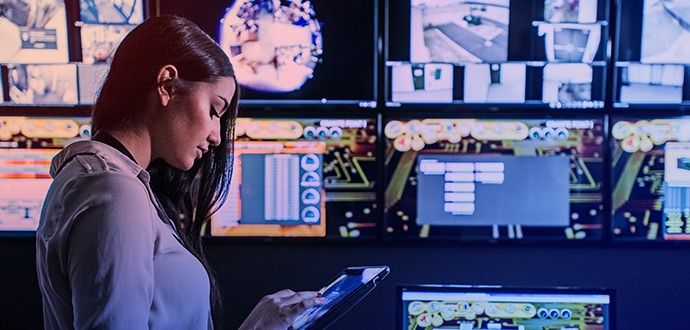-
Featured services
2026 Global AI Report: A Playbook for AI Leaders
Why AI strategy is your business strategy: The acceleration toward an AI-native state. Explore executive insights from AI leaders.
Access the playbook -
Services
View all services and productsLeverage our capabilities to accelerate your business transformation.
-
Services
Network Services
-
Services
Cloud
-
Services
Consulting
-
-
Services
Data and Artificial Intelligence
- AI and Intelligent Solutions
- Data/AI Strategy and Program
- Data Engineering and Platforms
- Data Governance and Management
- Data Visualization and Business Decision
- GenAI Consulting
- GenAI Platforms
- GenAI Industry Services
- GenAI Infrastructure Services
- GenAI Value Transformation
- View Data and Artificial Intelligence
-
Services
Infrastructure Solutions
-
Services
Global Data Centers
-
Services
CX and Digital Products
-
Services
Application Services
-
Services
Sustainability Services
-
Services
Digital Workplace
-
Services
Business Process Services
-
Services
Generative AI
-
Services
Cybersecurity
-
Services
Enterprise Application Platforms
![]()
Accelerate outcomes with agentic AI
Optimize workflows and get results with NTT DATA's Smart AI AgentTM Ecosystem
Create your roadmap -
-
-
Insights
Recent Insights
-
The Future of Networking in 2025 and Beyond
-
Using the cloud to cut costs needs the right approach
When organizations focus on transformation, a move to the cloud can deliver cost savings – but they often need expert advice to help them along their journey
-
Make zero trust security work for your organization
Make zero trust security work for your organization across hybrid work environments.
-
-
![]()
2026 Global AI Report: A Playbook for AI Leaders
Why AI strategy is your business strategy: The acceleration toward an AI-native state. Explore executive insights from AI leaders.
Access the playbook -
-
2026 Global AI Report: A Playbook for AI Leaders
Why AI strategy is your business strategy: The acceleration toward an AI-native state. Explore executive insights from AI leaders.
Access the playbook -
Discover how we accelerate your business transformation
-
About us
CLIENT STORIES
-
Liantis
Over time, Liantis – an established HR company in Belgium – had built up data islands and isolated solutions as part of their legacy system.
-
Randstad
We ensured that Randstad’s migration to Genesys Cloud CX had no impact on availability, ensuring an exceptional user experience for clients and talent.
-
-
CLIENT STORIES
-
Liantis
Over time, Liantis – an established HR company in Belgium – had built up data islands and isolated solutions as part of their legacy system.
-
Randstad
We ensured that Randstad’s migration to Genesys Cloud CX had no impact on availability, ensuring an exceptional user experience for clients and talent.
-
![]()
2026 Global AI Report: A Playbook for AI Leaders
Why AI strategy is your business strategy: The acceleration toward an AI-native state. Explore executive insights from AI leaders.
Access the playbook -
- Careers
Optimize the workplace for outstanding employee experience
Designed for productivity and automated for efficiency, the intelligent workplace works for employees and customers alike. It’s also flexible enough to accommodate changes in the work we do, the work machines do, and how we cooperate and collaborate in the era of the Fourth Industrial Revolution.
The rise of the modern collaboration estate
Employee experience takes center stage as organizations look to bring collaboration and productivity tools together on one platform.
While we still talk about work–life balance, there’s an increasing blend of the two as work becomes more closely linked to our individual purpose, achievement and even wellbeing. Today’s employees want to be measured on their contribution and outcomes, not the hours they clock up. They expect the organizations they work for to give them the freedom, flexibility and tools to do what they love, and do it well.
But there’s been a disconnect between the powerful, user-friendly tools people use in their personal lives – smartphones, messaging and file-sharing applications like WhatsApp and Dropbox – and the somewhat limited, mostly unintegrated, tools available ‘at the office’.
As organizations compete to attract the right talent through the company’s sustainability message and modern collaboration systems, it’s HR rather than IT that’s driving digital workplace initiatives.
Accelerate your move to a single collaboration platform
The modern collaboration estate bridges these gaps by bringing together unified communications and productivity systems in the same estate. With telephony, messaging, videoconferencing, Office365 and GSuite on the same platform, it’s easier to deliver the experience employees expect.
54% of participants recognize the high importance of transforming the employee experience, and the ways people perform their jobs, through digital initiatives.
'Moving to cloud requires a communications platform that is agile, flexible and dependable enough to be the foundation for employee workstyles and customer journeys that the enterprise needs to develop, adapt and continuously improve.'
Mark Alexander, Executive Vice President, Cloud Communications division, NTT Ltd.
Follow on LinkedIn
The growing spotlight on agile ways of working
There’s a shift from individual to team productivity as digital, software-based solutions have a big impact on how people work.
Digital applications and software-based everything are making a significant impact on how people work. As organizations seek to enable cross-functional, project-based teams from around the world, there’s a greater focus on productivity and collaboration solutions that offer flexibility and support a more agile way of working.
Artificial intelligence is accelerating this trend by making collaboration processes far more efficient. Virtual assistants can book venues, synchronize agendas, take notes, assign actions and set up follow-up meetings – making it easier for individuals to connect and work as teams, and enabling greater productivity.
Focus on enabling teams
The tools and applications your organization uses must do more than enable individual productivity: they must also empower teams. Any productivity solution must therefore fit your processes, culture and ways of working – and be flexible enough to accommodate a wide range of work styles.
70% of organizations say that one of the tangible benefits of their digital strategy is shaping new ways of working through organizational transformation.
NTT 2019 Digital Means Business Benchmarking Report
The dual role of smart buildings
Smart buildings are being designed with both environmental sustainability and employee happiness in mind.
Workspace design has evolved to consider employee wellbeing and productivity alongside factors such as reducing running costs and minimizing environmental impact.
Activity-based environments are being designed with several factors in mind, first and foremost being the needs and preferences of people who use them. Think workspaces with private rooms for calls, coffee stations for recharging and connecting, and meeting rooms with interactive whiteboards.
Smart buildings will run on the Internet of Everything, where technology is used to make people more comfortable – for example, by adjusting temperatures, lighting and even aromas to suit individual preferences. Sentiment analysis can measure how employees are really feeling and assist with human capital management.
Design spaces that make employees happy
To optimize the use of space for maximum impact on positivity and productivity, get employee input into every aspect of design, from the look and feel of the spaces to the names of meeting rooms. Address any concerns about the use of data captured by IoT sensors. Such data should either be anonymized to show broad trends or used for the purposes of adapting the environment to individual preferences – not as a management tool for analysing productivity.
The top two strategies for meeting evolving workforce demands are flexible working (56.6%) and workspace environment (52.8%).
Dimension Data 2019 Global Customer Experience Benchmarking Report
'In enterprise communications, one size does not fit all. Organizations need tools to empower the way their employees want and need to work, enabling their workforce to communicate with the market in ways their clients want to be engaged.'
Dr Fiona Lodge, Product & Strategy Officer, Cloud Communications division, NTT Ltd.
Follow on LinkedIn
The impact of split-second customer loyalty
Customer stickiness is vital in a digital world. When you have only a few seconds to prove yourself, you need every touchpoint on the customer journey to have maximum impact.
Unless the business is digitally born, the data needed to fuel CX lies in different systems across the organization – customer relationship management, enterprise resource management, sales, invoicing – all of which need to be brought together to create a single, connected customer journey.
Make the single source of data a strategic priority
For most organizations, it’s not technology systems but internal business silos that hold them back from connecting the data that connects their customers. The solution to a unified customer platform therefore lies in strategic focus and execution rather than technology implementation alone. Set the right key performance indicators for the right person, at an executive level, so there’s one point of accountability for driving this in the organization.
Of the 56.3% of organizations that have a single person accountable for CX in the organization, 69.6% say there is no CX representation at board level.
Dimension Data 2019 Global Customer Experience Benchmarking Report
The effectiveness of the data-driven organization
With humans working alongside machines, the way organizations visualize and use data will be key to successful outcomes.
In the Fourth Industrial Revolution, anything that can be automated, will be. Humans will get involved only when machines can’t understand the context of a situation well enough to answer a query or resolve a customer problem.
Natural-language processing will be used in the first steps of a client interaction, while machine learning will analyse sentiments and preferences and direct customers appropriately. Robotic process automation will identify issues and either address them directly or alert a human to intervene.
Creating the ideal combination between what a machine does and what a human does will be critical. And the foundation of all of this is how you use the data you have throughout the customer journey.
Implement artificial intelligence and machine learning to accelerate opportunities
To become an effective, data-driven organization, start with the business problem then work down to the technology: where can artificial intelligence and machine learning automate processes, improve the customer experience and make life easier for employees?
Automation will replace between 11% and 25% of CX-led activity currently performed by agents by 2020, say 32.7% of organizations.
Dimension Data 2019 Global Customer Experience Benchmarking Report
'There’s been a disconnect between the powerful, user-friendly tools people use in their personal lives and the somewhat limited, mostly unintegrated, tools available "at the office".'
Nemo Verbist, Senior Vice President, Intelligent Business and Intelligent Workplace, NTT Ltd.
Follow on LinkedIn
Disruptive technologies to watch
Embedding technologies into physical spaces to create immersive, responsive ‘phygital’ spaces, where the physical world blends with the digital.
NTT’s Cokoon Project aims to take any physical space – a meeting room, office, shop, VIP box in a stadium – and plug in a limited series of technologies to transform it into a virtual environment that can create any range of experiences.
Five-sense immersion | Real-time response |
With digital technologies, we can create any experience | Technologies not only detect but also respond to what is |
Digital spaces can be created in any industry where real estate needs some kind of disruption to move from being a static, analog environment to more dynamic, responsive environment.
We’re building the first Cokoons for NTT itself and are exploring other uses for this concept, for example:
- Retail: To reclaim some traffic from online shopping, the new frontier for retail outlets is to create such an amazing experience in-store that it’s incomparable to the online experience.
- Healthcare: Embedding this immersive, responsive solution in children’s hospitals can transform a long, complex and often distressing experience into a friendly, relaxed and interactive one.










